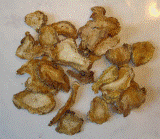- Soreness, pain, and numbnessin the neck,
back and lower extremities due to Wind Damp painful obstruction. Use with
Asarum
heterotropoides- Xi xin and
Gentiana
macrophylla- Qin jiao.
[4]
- Headache due to externally contracted Wind Cold Dampness, with
Notopterygium
incisum- Qiang juo,
Ligusticum sinense-
Gao ben and
Vitex trifolia- Man jing zi.
[4]
- Externally contracted Wind Cold without sweating, but with body aches and
pains, with
Ephedra sinica- Ma huang.
[4]
- Numbness in the legs, with
Ledebouriella
divaricata- Fang feng.
[4]
- Toothache associated with Wind Cold, with
Ledebouriella
divaricata- Fang feng and
Angelica dahuria-
Bai zhi.
[4]
[1] Barefoot Doctor's Manual- 1977 Prepared by the Revolutionary Health Committee
of Hunan Province. Original Chinese manual- Victor W. Sidel. Originally published
by Dr Joseph Quin and the Fogarty International centre, Bethdesda (1974). Madrona
Publishers Seattle Washington ISBN 0-914842-52-8
[2] A Complete English Dictionary of Medicinal Terms in Chinese Acupuncture and
Herbalism 1981 - Henry Lu Chinese Foundations of Natural Health- The Academy of
Oriental Heritage, Vancouver, Canada.
[3] Translation notes from Gary Seiford and Hocu Huhn- NSW College of Natural
Therapies. Sydney Australia (1982).
[4] Chinese Herbal Medicine Materia Medica- Dan Bensky and Andrew Gamble- Eastland
Press 1986 Seattle Washington ISBN 0-939616-15-7
Images
1.
mitomori.co.jp
2.
[1]
3.
plumdragonherbs.com
Angelol, angelicone, bergapten, asthol, umbelliferone, scopoletin, angelic acid,
tiglic acid, palmitic acid, sterols, stearic acid, linolenic acid, glucose, essential
oils.[1]
References
[1] Chinese Herbal Medicine Materia Medica- Dan Bensky and Andrew Gamble- Eastland
Press 1986 Seattle Washington ISBN 0-939616-15-7
 Angelica
pubescens. 独 活 Dú
huó Downy Angelica Family: Umbelliferae
Angelica
pubescens. 独 活 Dú
huó Downy Angelica Family: Umbelliferae

 HABITAT:
Grows wild in ravines and thickets.
HABITAT:
Grows wild in ravines and thickets.